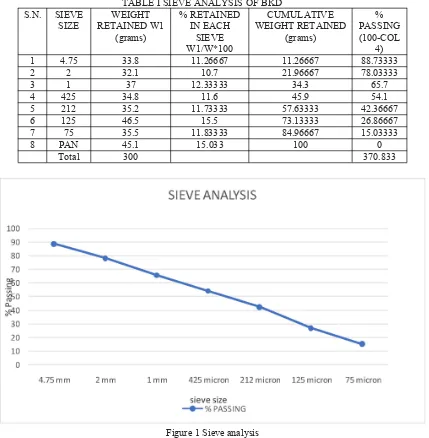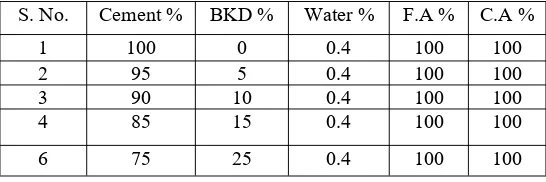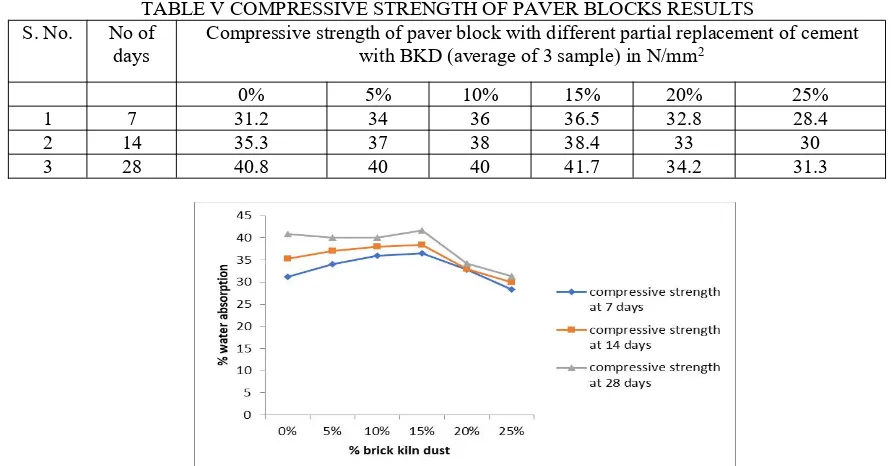© IJEDR 2019 | Volume 7, Issue 2 | ISSN: 2321-9939
Use of Brick Kiln Dust Waste in Paver Block to
Improve its Mechanical Properties
1Bhupesh Goyal,2Pardeep Kumar Gupta 1Student,2Professor
Punjab Engineering College, Chandigarh
_____________________________________________________________________________________________________ Abstract— Concrete paver blocks are special pre-cast pieces of concrete blocks of non-interlocking or interlocking types, commonly used in exterior landscaping pavement applications. Properly designed and constructed paver blocks give excellent performance at locations where conventional pavement systems have lower service life due to a number of environmental, geological constraints. But with the use of high-performance concrete they can be designed to sustain light, medium, heavy and very heavy traffic conditions under any constraints. The objective of the present work was to evaluate the performance of concrete modified with brick kiln dust for paver blocks for use in pavements and other application areas. As compressive strength, and water absorption are the most significant properties for concrete paver blocks the same have been studied for various concrete mixes with varying percentages of brick kiln dust. Brick kiln dust was used as partial replacement of cement in the study and six percentages 0%, 5%, 10%, 15%, 20%, 25% for dumbbell shape paver blocks. The mix with 15% replacement was found to give maximum compressive and maximum water absorption for all types of paver blocks.
Keywords— Paver block, Brick kiln dust, compressive strength, water absorption, Interlocking
_____________________________________________________________________________________________________
I. INTRODUCTION
The use of interlocking pavement blocks has a long history behind it. Remnants of interlocking pavement blocks roads built by Roman scan be still found today. However, the real popularity of concrete pavement blocks started when they began to be used in big way in Netherlands in the 1940s. The first interlocking concrete pavement blocks were shaped and sized just like bricks. In fact, since they were first used in Netherlands or Holland, they were called “Holland Stones”. In India, they are now finding an increasing number of applications, with demand being generated from both the realty and the infrastructure development sectors. Interlocking concrete block pavement (ICBP), as they are often referred to in technical parlance, are fast finding an increasing number of takers in India. While they may have made their entry into the Indian market about a decade ago, they have been in use for decades together in several other countries.
A. ADVANTAGES
Mass production under factory conditions ensures availability of blocks having consistent quality and high dimensional accuracy.
Good quality of blocks ensures durability of pavements, when constructed to specifications. ICBP does not require curing, and so can be opened for traffic immediately after construction. Construction of ICBP is labour intensive and requires less sophisticated equipment.
Low maintenance cost and a high salvage value ensures low life cycle cost.
B. LIMITATIONS
Poor surface riding quality.
Speed of vehicle restricted to 60 kmph.
Due to Low surface resistance skidding of vehicle. Breaking of paver blocks especially corner breaks.
II. MATERIALS AND METHODOLOGY A. Material
TABLE I SIEVE ANALYSIS OF BKD S.N. SIEVE
SIZE RETAINED W1WEIGHT (grams)
% RETAINED IN EACH
SIEVE W1/W*100
CUMULATIVE WEIGHT RETAINED
(grams)
% PASSING (100-COL
4)
1 4.75 33.8 11.26667 11.26667 88.73333
2 2 32.1 10.7 21.96667 78.03333
3 1 37 12.33333 34.3 65.7
4 425 34.8 11.6 45.9 54.1
5 212 35.2 11.73333 57.63333 42.36667
6 125 46.5 15.5 73.13333 26.86667
7 75 35.5 11.83333 84.96667 15.03333
8 PAN 45.1 15.033 100 0
Total 300 370.833
Figure 1 Sieve analysis Fineness Modulus = (total % passing/ 100)
= 370.8333/100 = 3.708
Specific Gravity Test: specific gravity of BKD fraction passing 4.75 mm I.S sieve is done by using density bottle. Observation take is in the table II
TABLE II SPECIFIC GRAVITY OF BKD S. No. Observation
1 Weight of the sample in g 400
Specific Gravity = 2.35
ii) Cement: Various types of cement can be utilized for production of precast concrete paver block as per IS 15658: 2006. But in this experimental study the OPC 43 Grade cement has been utilized which confirming IS 8112: 1989. iii) Fine aggregate: As per concerning IS 15658: 2006 Fine aggregates shall conform to the requirements of IS 383 both
river/quarry sand and stone dust meeting the requirements can be used.
iv) Coarse aggregate: As per concerning IS 15658: 2006 coarse aggregate shall conform to the requirement of IS 383. For ensuring durability, the aggregate used for the manufacturing of paver blocks shall be sound and free from honeycombed particles in this experiment. In this experimental study nominal size of aggregate (12 mm) suggested for paver block is used.
v) Water: Used water is portable drinking water and free from organic solid materials as confirming to IS 456: 2000 having pH 7.5.
B. Mix Proportions
M35 grade of concrete is considered. Cement is replaced with Brick Kiln Dust in 5 different percentages namely 5, 10, 15, 20 and 25%. The mix design for concrete with Brick Kiln Dust is carried out as per IS 10262: 2009. Mix ratio for M 35 grade trial was 1:2.54:2.1 and w/c ratio taken 0.4. Details of mix proportion for M35 concrete are given Table III.
TABLE III MIX PROPORTION
S. No. Cement % BKD % Water % F.A % C.A %
1 100 0 0.4 100 100
2 95 5 0.4 100 100
3 90 10 0.4 100 100
4 85 15 0.4 100 100
6 75 25 0.4 100 100
C. CASTING ANDTESTING
Mould of rubber based with size 280 x 160 x 80 mm3taken for the preparation of dumbbell shaped sample of paver block. Firstly, the suitable w/c ratio is found by workability test. The material required like cement, water, fine aggregate and coarse aggregate were mixed together as per trial mix proportion and paver blocks were casted. After de-moulding, samples of paver block were kept in under shade for one day and after that samples were cured in water for determining compressive strength in Universal testing machine and calculating water absorption.
III.EXPERIMENTALPROCEDURES A. WATER ABSORPTION TEST
Water absorption was done by keeping block samples fully submerged in water. After 7 days blocks were taken out from the water and left for 2 minutes to drain. Visible water is removed from the sample by damping cloth and after that weight of samples are taken and its saturation weight. Then paver blocks are kept in the ventilated oven at 105±7°C for 24±2 hours and its dry weight is measured.
This procedure of water absorption test was carried out for samples after 14 and 28 days. The percentage of water absorption is calculated as
Where,
Ww = Saturation weight of paver block Wd= Dry weight of paver block
Water absorption percentage with different partial replacement of cement (average of 3 sample) is given in table IV TABLE IV WATER ABSORPTION PERCENTAGE
S. No. No of
days Water absorption percentage with different partial replacement of cement(average of 3 sample)
0% 5% 10% 15% 20% 25%
1 7 0.87 2.53 2.74 3.85 3.08 2.58
Figure 2 Comparison of water absorption at 7, 14 and 28 days B. COMPRESSIVE STRENGTH
Compression test is carried out on dumbbell shaped paver block. At each desired curing periods specimens of paver blocks are taken out of water and dried. The blocks were taken for the test. The cubes are tested in Universal testing machine to get the compressive strength of concrete.
The paver block with dimension 200 x 160 x 80 mm3 have the actual surface plane are 28000 mm2. This helped to find out the compressive strength of paver block.
The result of compressive strength of paver block with different partial replacement of cement with BKD (average of 3 sample) in n/mm2 is mentioned in table V.
TABLE V COMPRESSIVE STRENGTH OF PAVER BLOCKS RESULTS S. No. No of
days Compressive strength of paver block with different partial replacement of cementwith BKD (average of 3 sample) in N/mm2
0% 5% 10% 15% 20% 25%
1 7 31.2 34 36 36.5 32.8 28.4
2 14 35.3 37 38 38.4 33 30
3 28 40.8 40 40 41.7 34.2 31.3
FIGURE 26 COMPARISON OF COMPRESSIVE STRENGTH OF PAVER BLOCK AT 7, 14 AND 28 DAYS IV. RESULT AND DISCUSSIONS
Water Absorption result
Water absorption test done as per IS 15658: 2000 for 7, 14, and 28 days. Comparison of water absorption at 7,14 and 28 days shown in figure 2 with replacement of cement with brick kiln dust. In table IV water absorption percentage is tabulated for 7, 14 and 28 days. As per figure 2 shown that the water absorption percentage is increasing as the number of days increasing and also varying with replacement of cement with brick kiln dust.
Compressive strength
V. CONCLUSIONS
For brick kiln dust concrete paving blocks, the compressive strength of concrete was increased depending upon replacement level. For w/c ratio 0.40, the improvement in compressive strength was observed at replacement level of 15% after this compressive strength of paver block get decreased
The value of water penetration depth as compared to control mix (replacement level 0%) increased gradually for the w/c ratio 0.40 . Maximum water penetration depth was observed as at 15% replacement level of brick kiln dust waste at w/c of 0.40. after this water absorption value decreased
Utilization of brick kiln dust waste will solve the disposal problem associated with this waste material. Also modified concrete paving blocks will reduce the CO2 emission because of less consumption of cement which intern will clean the environment. It may be also noted that the saving in cement will conserve the natural recourses and will reduce the energy demand needed in the production of cement. Hence, Utilization of brick kiln dust waste in concrete paving blocks will produce more sustainable concrete
VI. REFERENCES
[1] IS:15658:2006 on "Precast Concrete Blocks for Paving – Specification," Bureau of Indian Standards,
[2] Muraleedharan, T. and Nanda, P.K., 1992 "Application and Performance of Interlocking Concrete Block Pavement – An Overview," The Indian Concrete Journal, pp 395 -400, July 1992
[3] Panda B.K. and A.K. Ghosh, “Structural Behavior of Concrete Block Paving. 2. Concrete Blocks”, Journal of Transportation Engineering, Vol. 128, No. 2, March 2002, ASCE
[4] Shackel, B. 1980, “An Experimental Investigation of the Roles of the Bedding sand and Jointing Sands in the Performance of Interlocking Concrete Block Pavements.” Concrete/Beton
[5] IS: 2386-1963, Methods of test for aggregates of concrete, part I, III & IV, Bureau of Indian Standards, New Delhi, 1963 [7]
[6] IS: 383-1970, Specification for coarse and fine aggregate, Bureau of Indian Standards, New Delhi, 1970
[7] Reddy . E. Anji , Gupta vishal 2015, “ effect of partial replacement of cement with rice husk ash using nylon fiber in concrete paver block.
[8] Radhikesh P. , Nanda ,Amiya K.Das and N.C. Moharana, , “Stone crusher dust as a fine aggregate in concrete for paving blocks”, International Journal of Civil and Structural Engineering, Vol. 1, Issue 3, pp 613-620, 2010.
[9] Ganesh Tapkir, Satish Parihar, Pramod Patil and Hemraj R Kumavat, “Recycled plastic used in concrete paver blocks,” International Journal of Research in Engineering and Technology, Vol. 3, Issue 9, pp 33-35, 2014.


